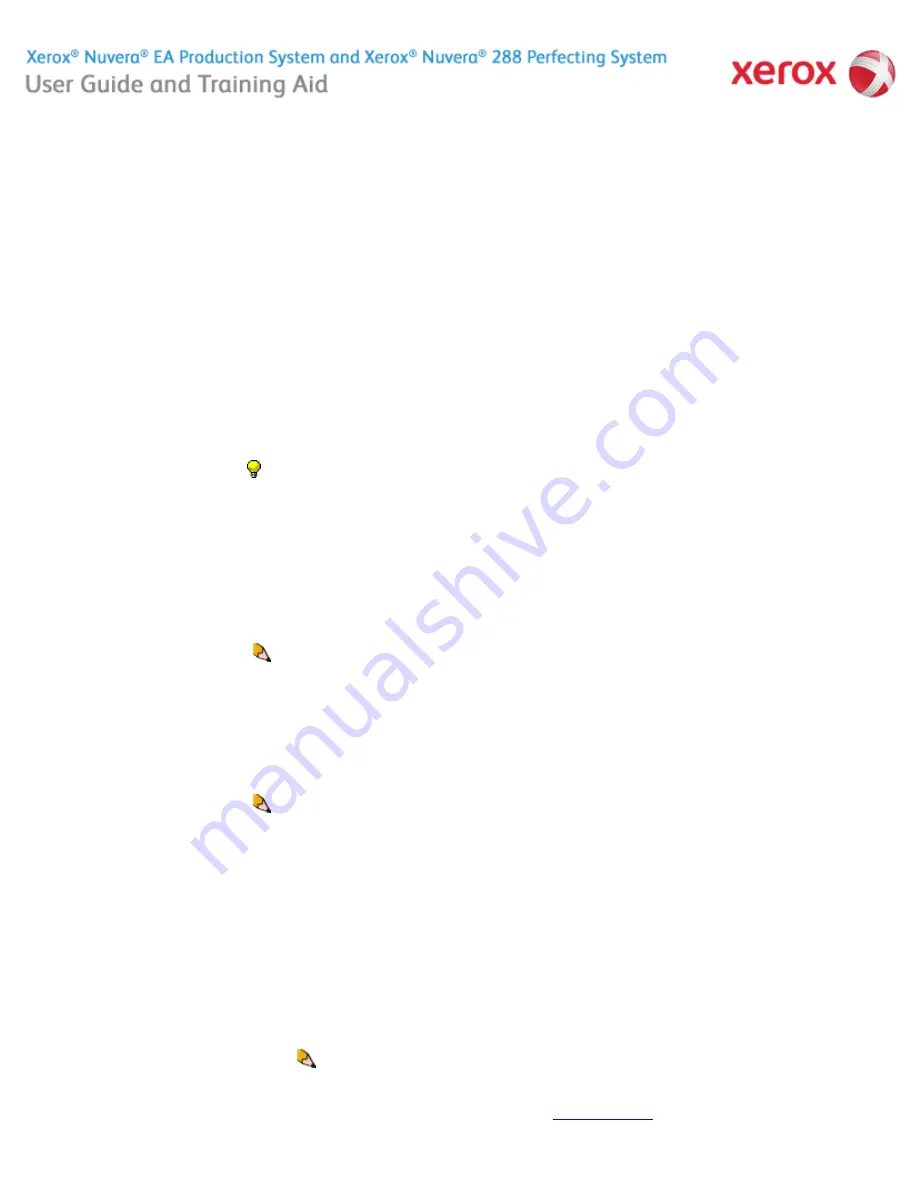
file:///C|/Documents%20and%20Settings/Miz%20B/My%2...TA/Nuvera%209.0%20UGTA_FINAL/English/hdi_p_015.htm (1 of 2)8/13/2008 2:19:36 PM
Printing with the Parallel RIP feature
The Xerox Nuvera 288 Perfecting System includes page independent Parallel RIP (PPR) as a standard feature used to improve image
processing performance and print speed, especially for complex documents.
How the Parallel RIP process works
Parallel RIP works with page independent jobs that are compliant with Adobe Document Structuring Conventions (DSC) 3.0, such as
compliant PS, VIPP, and PDF.
When Parallel RIP is enabled from the Queue Manager, FreeFlow Print Server first determines if the current job is eligible for Parallel
RIP. If it is not eligible, the job is processed on a single RIP, which may leave one or more of the remaining RIPs available to process
the next waiting job. If it is, FreeFlow Print Server splits jobs, or pages of a single job, and distributes them to the separate RIP
processes running on the two separate CPUs. The maximum number of RIPs available depends on the number of processors and the
amount of memory on the FreeFlow Print Server. For instance, approximately 2 to 3 RIPs will run on one dual core CPU. If an optional
upgrade performance kit is installed with an additional dual core CPU, the system would then have four CPUs RIPping data (5 RIPs will
run on two dual core CPUs), increasing processing time and producing faster RIP speeds.
Which Jobs work best
Parallel RIP is ideal for long jobs with many nonrepeating scanned images or digital photographs such as text books, magazines,
yearbooks and product manuals.
Parallel RIP supports data streams PS, PDF, and VIPP Database Mode. To take full advantage of Parallel RIP performance for
PostScript or PDF jobs, always enable Parallel RIP at the printer queue and use DCS/Page Independence settings with
[Optimize for
Portability]
. For these types of PS and PDF jobs, you will see a 50% or more increase in performance when compared to a printer
queue without PPR set.
Jobs that are PCL, TIFF, ASCII, LCDS and IPDS will not benefit from Parallel RIP since they are not page independent or DSC
compliant data streams. Disable the PPR option for this type of job. It is best that a suite of this type go to a standard queue.
How to create a queue with Parallel RIP enabled
For an overview of more sophisticated jobs and work flows, see
Setup Complex Jobs
.
1. From Queue Manager, select [
New
] from the Queue pull-down menu.
2. Enter "Parallel" in the Queue Name text box.
3. On the Settings tab, select [
Raster Image Processor
].
4. Select [
Enable
] as the Parallel RIP setting.
5. Select [
Add Queue
] and [
Close
].
6. Select [
Setup: System Preferences
] and the
Job Processing
tab. The Allocated spin box shows the number of RIPs that
will be used for queues with Parallel RIP enabled. You can set the number of active RIPs, however, FreeFlow Print Server
software automatically determines the optimal use of available processors depending upon the platform resources and the job
flow. The best overall productivity is gained when the Allocated RIPs number is left at the recommended default setting.
7. Using the Parallel queue, print the job.
Home
|
Resources
|
Search
|
Index
|
How Do I?
|
System Tour
|
|
Maintenance
NOTE
: You can use the PostScript print driver to create page independent PS jobs. In the PostScript printer, select driver
option
[Page Independence]
or
[Optimize for Portability]
to produce page independent output. Do not set the driver option to
[Optimize for Speed]
, which generally produces output that is not page independent and not suitable for Parallel RIPping.
NOTE
: It is recommended that you enable Parallel RIP at all times unless printing a VI job or a job with multiple repeated
objects. Before enabling Parallel RIP, turn off the Administrative Pages option (banner, error and property pages) as this
selection requires special processing.
Problem Solving
TIP:
To see the number of parallel RIPs configured on the system, select
[Setup: System Preferences: Job Processing tab]
.
About this Site
NOTE
: The number of Allocated RIPs should match the Recommended number of RIPs, unless directed otherwise by
a Xerox Support representative.
76 of 256






























